1. 서론
산채류는 산의 자생풀이나 나무의 싹 등과 같이 산에서 나는 먹을 수 있는 식물을 말한다. 우리나라에서의 산채는 척박한 기후와 토양에서 적응하며 살아왔기 때문에 그 맛과 향이 강하고 많은 기능성 물질을 함유하는 것으로 평가되고 있다(Kim, 2016). 하지만 산채류 중 일부 품목만이 생산과 판매가 되고 있으며, 나머지 저이용 임산자원은 그 생산량과 수요가 많지 않다(Byun, 2019). 또한, 산채류는 수확 후 바로 섭취하거나 간단한 가공을 거친 1차 가공품이 대부분이며, 이러한 판매는 부가가치의 증대하기 어려운 상황이다(Kim과 Seok, 2019). 그럼에도 산채는 이용가치가 높고 phenolic 화합물 등 다양한 기능성 물질을 함유하고 있다고 보고되고 있다(Baek, 2020). 따라서 산채류를 단순가공한 제품이 아닌 맛, 향 그리고 기능성이 증가된 발효가공 기술을 적용해 활용도는 높이는 기능성 소재 개발이 필요한 실정이다.
약용류 꾸지뽕나무 및 수실류 돌배는 임업 및 산촌 진흥촉진에 관한 법률 시행령 제8조 제2항에 따른 임산물 소득원의 지원 대상으로 이용률을 높여야 할 필요가 있는 품목이다(Kofpi, 2023). 꾸지뽕(Maclura tricuspidata)은 한국을 비롯한 중국, 일본에 주로 분포하는 식물로, 꾸지뽕나무속에 속하는 낙엽활엽 소교목이다(Ju, 2022). 동의보감의 기록에 따르면 꾸지뽕은 자양강장, 숙취해소, 불면증 등 다양한 효능이 있다고 알려져 있으며, 다양한 phenolic compound, flavonoids, xanthone계의 물질들을 함유하고 있고 항균, 항산화활성, 면역 증진, 혈행 및 체지방 개선 등에 효과가 있다고 보고되어 있다(Cho 등, 2018; Choi 등, 2009; Choi 등, 2015; Park, 2018). 그리고 돌배(Pyrus pyrifolia)는 우리나라 남부 일부지역에 한정적으로 분포하는 돌배나무류 낙엽활엽교목으로 해열, 이뇨, 항당뇨 등의 효과가 보고되어 있다(Lee, 2016). 하지만 꾸지뽕과 돌배는 보유하고 있는 기능성에 비해 다소 떨어지는 맛과 향, 또는 적은 생산량으로 임산자원 중에서는 저이용 임산자원으로 분류되며 고부가가치 연구가 필요할 것으로 판단된다.
도라지(Platycodon grandiflorum)는 한국, 일본, 중국에 분포하는 다년생 뿌리 약초로, 기관지나 폐 질환에 대한 개선이 우수하다고 알려져 있고(Park 등, 2022), 그와 비슷하게 다년생 뿌리 약초인 더덕(Codonopsis lanceolata)은 사포닌 성분인 platycodin과 inulin 성분이 다량 함유되어 있어 도라지와 마찬가지로 기관지건강, 면역 강화, 항암, 당뇨 등 다양한 기능성을 포함하고 있다(Im 등, 2021; Kim 등, 2009; Lee 등, 2017; Ryu, 2008; Yun 등, 2014). 또한, 도라지와 더덕은 발효기술을 통하여 항산화, 항염증 등 기능이 향상되고 맛이 개선되는 연구가 보고되고 있다(Lee, 2021; Lee 등, 2015; Seong 등, 2018).
복합발효는 다양한 균주의 활성을 활용할 수 있다. 효모는 amylase나 cellulase 등과 같은 효소 활성이 뛰어나고 비타민 B군과 다양한 생리활성물질을 함유하는 것으로 알려져 있다(Kratichvilova, 1990; Um 등, 2017). 또한, 당을 사용하여 ethanol과 다양한 향기성분을 생성하여 이미나 이취를 제거하는 데 용이하다(Lee 등, 1996). 유산균은 탄수화물을 활용하여 젖산을 생성하는 균주를 통칭하며, 특유의 산미를 활용하여 맛과 기호성을 높이는 효과로 다양한 발효식품에 적용되고 있다(Mun, 2022). 또한, 가열 등을 활용하여 불활성시킨 사균체를 para-biotics라고 하며, 이러한 사균체 역시 다양한 기능성을 보유하고 있다(Choi, 2020). 효모와 유산균으로 복합발효한 아로니아(Kim, 2021), 고초균과 유산균으로 복합발효한 황칠나무(Son, 2023), 고초균과 유산균으로 복합발효한 수삼(Park 등, 2019)에 관한 복합발효를 통한 생물전환 연구가 보고되어 있다.
따라서 본 연구에서는 우리나라 임산자원 중 저이용으로 보고된 꾸지뽕과 돌배를 주재료로 이용하고 기관지 및 폐 기능 개선 효과가 뛰어난 더덕과 도라지를 부재료로써 혼합한 후 복합발효를 진행하였다. 주재료를 통해서 단일발효와 복합발효의 차이를 확인하였으며, 복합발효로 진행된 기간에 따라 생리 활성물질의 변화와 항염증 효능을 분석하고, 최적의 발효기간을 검토하였다. 종합적으로, 호흡기 관련 전염성 질환이 유행하는 시기에 항염증 관련 연구를 통해 저이용 산채류들의 활용가치를 높이고자 연구를 진행하였다.
2. 재료 및 방법
본 실험에 사용한 꾸지뽕, 돌배, 더덕, 도라지는 전라북도 진안군 소재에 있는 영농조합법인 진안당(Jinan, Korea)에서 구입하였다. 모든 산채류는 세척 후 분쇄하여 sludge 형태로 사용하였다. 그리고 발효의 종균으로 활용한 밀코지는 (유)이오엔자임(Jeonju, Korea) 제품을 사용하였고, 효모(송천발효, Cheongyang, Korea)는 전통주 및 막걸리 제조용 효모인 Saccharomyces cerevisiae를 구입하였으며, 유산균은 Lactobacillus sp.와 cellulase계 효소인 Sumyzyme AC는 ㈜비전바이오켐(Seoul, Korea)에서 구입하여 사용하였다. 또한, phenolic compound 분석에 사용된 표준품은 Sigma-Aldrich Co. Ltd. (St. Louis, MO, USA) 제품을 사용하였고, Acetonitrile 등 용매 시약은 J. T. Baker (Avantor Performance Materials, LLC, Radnor, PA, USA)의 high performance liquid chromatography (HPLC)급을 사용하였다.
산채류를 활용한 단일발효물을 제조하기 위하여 다음과 같이 진행하였다. 먼저 꾸지뽕과 돌배를 20 g 취한 뒤, 물 100 mL를 가수하였다. 물을 가수한 꾸지뽕과 돌배는 각각 B (균주 비첨가 비교군), C (밀코지 1%), D (효모 1%), E (유산균 1%), F (밀코지+효모+유산균 각 1%) 조건으로 균주를 접종한 뒤 30°C에서 48시간 동안 150 rpm으로 진탕배양하였다. 각각의 산채류 발효물은 0.45 μm Syringe filter로 여과한 후 HPLC로 phenolic compound를 탐색하였고, 분석조건은 Table 1과 같다.
산채류를 활용한 복합발효물을 제조하기 위하여 다음과 같이 진행하였다. 먼저 꾸지뽕 1.3 kg, 돌배 1.3 kg, 더덕 200 g, 도라지 200 g을 배합한 뒤 물 2 L를 첨가한 후 Sumyzyme AC 0.1%를 첨가하여 50°C에서 5시간 동안 효소반응시켰다. 그와 동시에 밀코지를 활성시키기 위해 밀코지 240 g, 정백당 800 g, 정제소금 40 g에 물 3 L를 배합한 뒤 상온에서 5시간 동안 활성시켰다. 그 후 효소반응물과 활성 밀코지를 배합한 뒤 건조효모 8 g, 건조유산균 8 g과 추가 영양원으로 구연산 80 g, 양조식초 16 mL를 첨가하고 잘 섞어준 뒤 20°C에서 발효를 진행하였다. 이 복합발효물은 6일마다 취하여 분석을 진행하였다.
산채류를 활용한 복합발효물의 일반성분분석을 위해 다음과 같이 진행하였다. 먼저 pH와 °Brix는 각각 pH meter (S-20K, Mettler Toledo, Greifensee, Switzerland)와 디지털당도계 (PAL-3, Atago, Tokyo, Japan)를 활용하여 측정하였다. 총산도 측정은 시료 1 mL에 증류수 10 mL를 가한 후 0.1% phenolphthalein 용액을 3-4방울 가하고 0.1 N sodium hydroxide 용액으로 적정하였다. 적정이 끝난 후 0.1 N sodium hydroxide 소모량을 확인하여 총산도(%)를 계산하였고, 그 계산식은 다음과 같다.
산채류를 활용한 복합발효물의 phenolic compound 및 flavonoid의 조성 및 함량을 분석하기 위해 다음과 같이 진행하였다. 먼저 시료는 0.45 μm Syringe filter를 활용하여 여과한 후 HPLC를 통해 분석을 진행하였고 분석조건은 Table 1과 같다. 그리고 각 phenolic compound를 정량하기 위해 각각의 phenolic compound의 표준물질을 분석하여 표준검량선을 그린 후 정량을 진행하였다.
산채류를 활용한 복합발효물의 total phenol 및 total flavonoid 함량을 분석하기 위해 다음과 같이 진행하였다. 먼저 total phenol 함량 분석을 위해 Folin-Ciocalteu법을 활용하였다(Singleton과 Rossi, 1985). 즉 시료 10 μL에 2% sodium carbonate 215 μL를 분주한 후 2분간 반응시켰다. 그 후 50% Folin-Ciocalteu phenol 시약 25 μL를 혼합한 후 실온에서 30분간 반응시켰다. 그 후 UV spectrophotometer (Synergy H1, Biotek, Winooski, VT, USA)를 활용하여 725 nm에서 흡광도를 측정하였다. 별도로 tannic acid를 이용하여 작성한 검량곡선으로부터 total phenol 함량을 구하고 mgTAE/100 g으로 표시하였다.
또한, total flavonoid 함량은 Zhishen의 방법에 따라 측정하였다(Zhishen 등, 1999). 즉, 시료 25 μL에 증류수 160 μL와 5% sodium nitrate 7.5 μL를 가한 뒤 5분간 반응시켰다. 이어서 10% aluminium chloride 7.5 μL를 가한 후 1분간 유지한 후 1 M sodium hydroxide 용액 50 μL를 가한 후 UV spectrophotometer를 사용하여 510nm에서 흡광도를 측정하였다. 별도로 quercetin을 이용하여 작성한 검량곡선으로부터 total flavonoid 함량을 구하고 mgQE/100 g으로 표시하였다.
산채류를 활용한 복합발효물의 DPPH radical 소거능은 다음과 같이 분석하였다. 0.2 mM 2,2-diphenyl-1-picrylhydrazyl을 제조하여 흡광도가 0.5-0.7이 되도록 희석한다. 그 후 시료 100 μL에 DPPH 시약 50 μL를 분주한 후 암소에서 10분간 반응시켰다. 그 후 UV spectrophotometer를 활용하여 517 nm에서 흡광도를 측정하였다. 그 후 아래 계산식을 활용하여 DPPH radical 소거능(%)를 측정하였다.
또한, ABTS radical 소거능은 다음과 같이 분석하였다. 먼저, 7.4 mM 2,2-azino-bis (3-ethylbenzothiazoline-6-sulfonic acid)에 2.45 mM potassium persulfate를 혼합하여 12시간 이상 상온에 방치하여 푸른색의 ABTS radical을 형성시킨다. 그 후 시료 50 μL에 ABTS 시약 100 μL를 분주한 후 암소에서 10분간 반응시켰다. 그 후 UV spectrophotometer를 활용하여 734 nm에서 흡광도를 측정하였고, 아래 계산식을 활용하여 ABTS radical 소거능(%)을 측정하였다.
산채류를 활용한 복합발효물의 NO 생성 억제능은 다음과 같이 분석하였다. 먼저 실험에 사용된 RAW 264.7 대식세포주는 한국세포주은행(Korean Cell Line Bank, Seoul, Korea)에서 구입하였다. RAW 264.7 세포배양을 위해 fetal bovine serum과 100 U/mL penicillin, 100 μg/mL streptomycin을 함유한 DMEM 배지를 이용하여 5% CO2 incubator (Galaxy 170 S, Eppendorf CO, Hamburg, Germany)에서 37°C, 습도 95% 이상으로 배양하였다. 배양한 RAW 264.7 대식세포주를 96 well plate에 1×106 cells/mL로 카운팅하여 각 well에 100 μL씩 분주하여 37°C, 5% CO2 incubator에서 24시간 배양하였고, 그 후 배지를 제거한 다음 LPS (100 ng/mL)와 시료를 농도별로 처리 후, 37°C, 5% CO2 incubator에서 24시간 배양하였다. 그 후 세포배양 상등액을 100 μL씩 96 well plate에 분주하고 NO assay kit (iNtRON Biotechnology, Boston, MA, USA)에서 N1 buffer를 50 μL 넣고 실온에서 10분 방치한 후, N2 buffer를 50 μL 넣고 실온에서 10분 방치하였고, ELISA microplate reader로 540 nm에서 흡광도를 측정하였다.
또한, western blot 실험은 다음과 같이 진행하였다. 먼저 RAW 264.7 세포를 6 well plate에 3×105 cells/mL로 seeding한 후 37°C, 5% CO2 환경에서 24시간 동안 배양했다. 그 후 복합발효물(0, 6, 12, 18, 24일 차)과 LPS 100 ng/mL를 동시에 처리하여 24시간 동안 배양했다. 이후 단백질을 추출하여 iNOS, COX-2, TNF-α 단백질 발현량을 측정하였으며, 추출한 단백질은 DC protein법으로 정량하였다. 전기영동은 SDS-polyacrylamide gel을 이용하였으며, polyvinylidene difluoride (PVDF) membrane에 transfer 하였다. 3% skim milk로 1시간 blocking한 후, 각각의 단백질에 대한 1차 antibody와 3% skim milk에 넣어 4°C에서 overnight 하였다. 그 후 PBS-T(PBS +0.1% Tween20)로 세척한 후 3% skim milk와 2차 antibody를 넣어 1시간 30분 동안 반응시킨 후 PBS-T로 세척하였으며, Ez westlumi one (ATTO, Tokyo, Japan)으로 발색하여 단백질 발현을 확인하였다. 1차 항체는 iNOS (Enzo Biochem Inc, Farmingdale, NY, USA), COX-2 (BD biosciences, Franklin Lakes, NJ, USA), TNF-α (Abcam, Cambridge, UK), β-actin (Santa cruz biotechnology, Dallas, TX, USA), 2차 항체는 goat anti-rabbit IgG (Cell signaling technology, Danvers, MA USA), goat anti-mouse IgG (Thermo fisher scientific, Waltham, MA, USA)을 사용하였다.
3. 결과 및 고찰
산채류를 활용한 복합발효물의 pH, °Brix 및 총산도의 6일차 별로 취하여 분석한 결과는 Table 2와 같다. 0일 차에 °Brix와 고형분함량은 각각 16.10, 14.60%이었다가 발효 6일 차에 6.71, 4.67%로 급격히 감소하는 것을 확인하였다. 또한, pH와 총산도는 발효 초기부터 24일 차까지 큰 변화는 보이지 않았고, 18일 차 이후 pH는 3.34로 약간 증가하고, 총산도는 1.12%로 약간 감소하는 것을 확인하였다. °Brix와 고형분함량은 초기에 가장 높았고, 점차 줄어드는 경향을 보였으며, 초기에 첨가된 정백당이 유용미생물에 의한 효소반응으로 유리당 생성을 한 것으로 판단된다.
Koji, yeast, LAB, koji + yeast + LAB을 각각 활용하여 꾸지뽕을 발효한 후 phenolic compound 및 flavonoid를 분석한결과는 Fig. 1과 같고, 돌배를 발효한 후 분석한 결과는 Fig. 2와 같다. 먼저 꾸지뽕을 발효한 결과, 발효 전보다 대체적으로 phenolic compound의 종류와 함량이 증가하는 것을 확인하였다. 특히 발효 전에 존재하던 gallic acid와 chlorogenic acid는 발효가 진행됨에 따라 감소하는 것을 확인하였고, 반면에 protocatechuic acid, 4-hydroxybenzoic acid, caffeic acid, ρ-coumaric acid, rutin는 발효 전보다 증가하는 것을 확인하였다. 이는 꾸지뽕 열매에 protocatechuic acid, 4-hydroxybenzoic acid, chlorogenic acid, rutin, taxifolin, quercetin 등의 phenolic acid 화합물을 함유하고 있다는 보고와 유사한 결과로 판단된다(Kim, 2017; Lee, 2021). 또한, 꾸지뽕의 생리활성 성분인 ρ-hydroxybenzylalcohol과 dihydrokaepferol의 함량이 증가되는 것도 확인하였다. 돌배의 발효물 또한 비슷한 경향을 보였는데, gallic acid는 감소하고 protocatechuic acid, chlorogenic acid, 4-hydroxybenzoic acid, rutin 등이 증가하는 것을 확인였다. 품종별 배에 chlorogenic acid, caffeic acid, gallic acid, 4-hydroxybenzoic acid, rutin, ρ-coumaric acid 등을 함유하고 있다는 앞선 연구와 일치하는 경향을 보여줬다(Choi, 2009). Gallic acid에서 4-hydroxybenzoic acid, protocatechuic acid로 전환되었고, chlorogenic acid에서 caffeic acid, ρ-coumaric acid로 전환된 것으로 판단된다(Tartik 등, 2023). 꾸지뽕에서의 ρ-hydroxybenzylalcohol의 증가는 gastrodin과 parishin에서 dihydrokaepferol과 ρ-coumaric acid의 증가는 quercetin과 kaempferol에서 전환되었을 것으로 판단된다(Kim 등, 2022). 위 실험으로 볼 때 미생물을 단일로 사용하는 것보다 복합으로 사용하였을 때 전환이 더욱 우수하다는 것으로 판단된다. 따라서 발효물 제조는 미생물을 단일로 넣는 것보다 복합으로 넣는 방법으로 선정하였다.
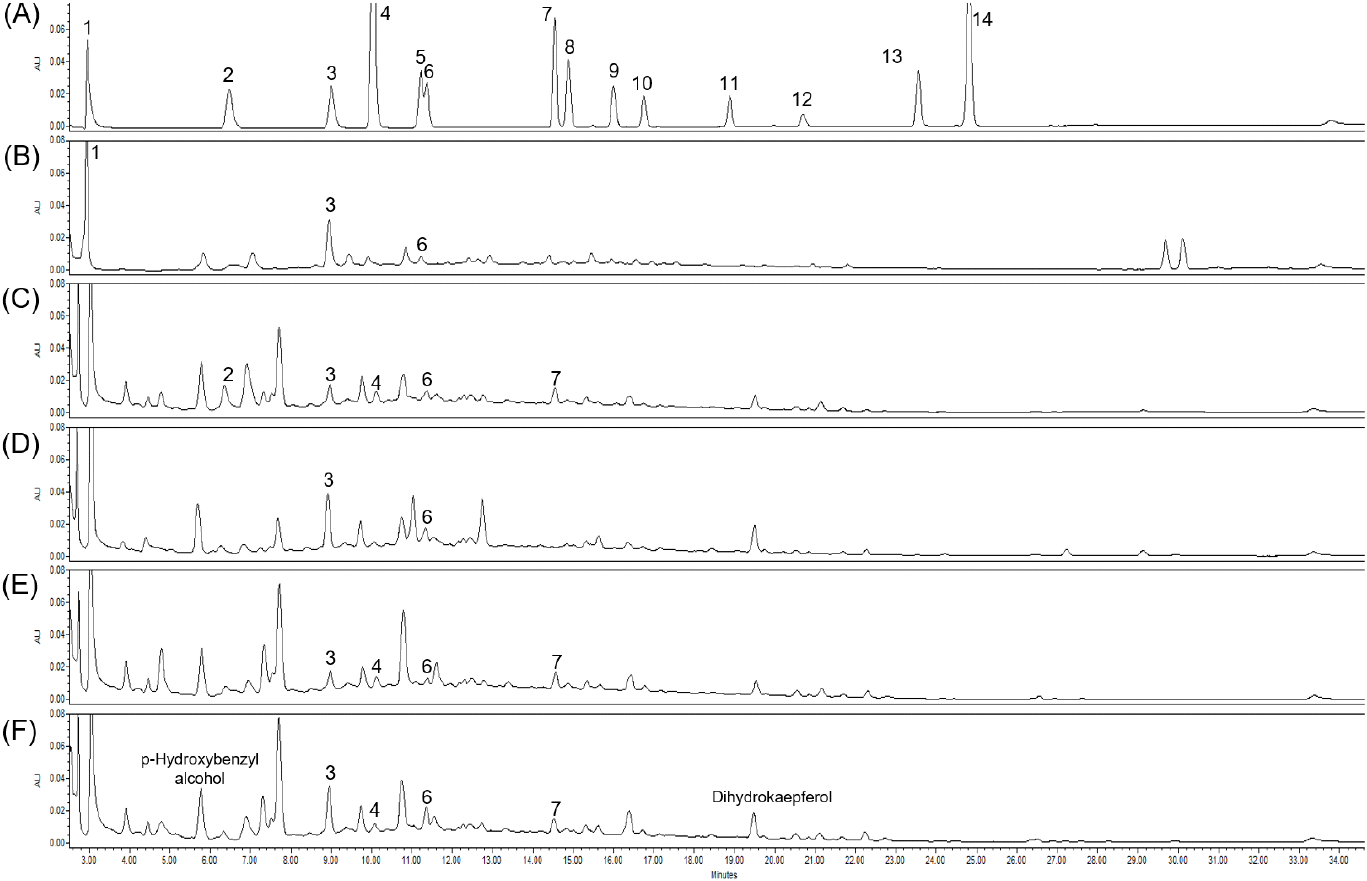

산채류를 활용한 복합발효물의 phenolic compound 및 flavonoid 분석 결과는 Table 3과 같다. 발효 초기에 낮았던 phenolic compound들이 발효가 길어짐에 따라 점차 증가하는 것을 확인하였다. 그 중 chlorogenic acid, 4-hydroxybenzoic acid, vanillic acid, caffeic acid는 발효초기 각 5.43 μg/mL, 12.30 μg/mL, 6.79 μg/mL, 28.14 μg/mL에서 24일 차까지 각 33.83 μg/mL, 46.21 μg/mL, 39.73 μg/mL, 51.46 μg/mL 증가하는 것을 확인하였다. 또한, ferulic acid, taxifolin, cinnamic acid, quercetin은 발효 초기에 각 12.30 μg/mL, 4.77 μg/mL, 0.03 μg/mL, 1.78 μg/mL에서 12일 차까지 각 23.22 μg/mL, 11.55 μg/mL, 0.84 μg/mL, 1.63 μg/mL로 증가하는 것을 확인하였다. 하지만 그 후 점차 감소하여 발효 24일 차에 각 17.74 μg/mL, 6.80 μg/mL, 0.72 μg/mL, 1.81 μg/mL로 확인되었다. 그리고 gallic acid, protocatechuic acid, rutin, ρ-coumaric acid, salicylic acid 성분은 발효 초기부터 24일 차 발효까지 성분이 검출되지 않았다. Kim (2021)은 꾸지뽕 열매를 효모로 발효할 시 caffeic acid, taxifolin, quercetin, 4-hydroxybenzoic acid 등이 발효 10일 차까지 꾸준히 증가한다고 하였으며, 이는 본 연구에서 12일 차 발효까지 phenolic acid 성분이 꾸준히 증가하는 것과 유사한 결과를 보였다.
산채류를 활용한 복합발효물의 total phenol 및 total flavonoid 함량 분석 결과는 Fig. 3과 같다. 발효 초기에 비해 발효기간이 길어짐에 따라 total phenol 및 total flavonoid 함량이 점차 증가하는 것을 확인하였으며, 발효 초기 total phenol 및 total flavonoid 함량은 각각 43.11 mgTAE/100 g, 10.97 mgQE/100 g으로 확인되었다. 점차 발효기간이 증가하면서 12일 차에 각 52.76 mgTAE/100 g, 16.33 mgQE/100 g까지 증가하였고, 18일 차쯤 total phenol 함량은 61.90 mgTAE/100 g으로 확인되었고, total flavonoid 함량은 14.77 mgQE/100 g으로 확인되었으며, 그 이후로는 감소하거나 유지하는 경향을 보였다. 앞선 연구에서 꾸지뽕을 유산균 등으로 발효하면 total phenol과 total flavonoid 함량이 증가한다는 연구결과가 있었으며(Kang 등 2013; Kim 등, 2012; Seo 등, 2013), 발효가 오래되면 오히려 감소하는 경향을 보인다고 보고와 일치하는 경향을 보였다(Jo, 2020).
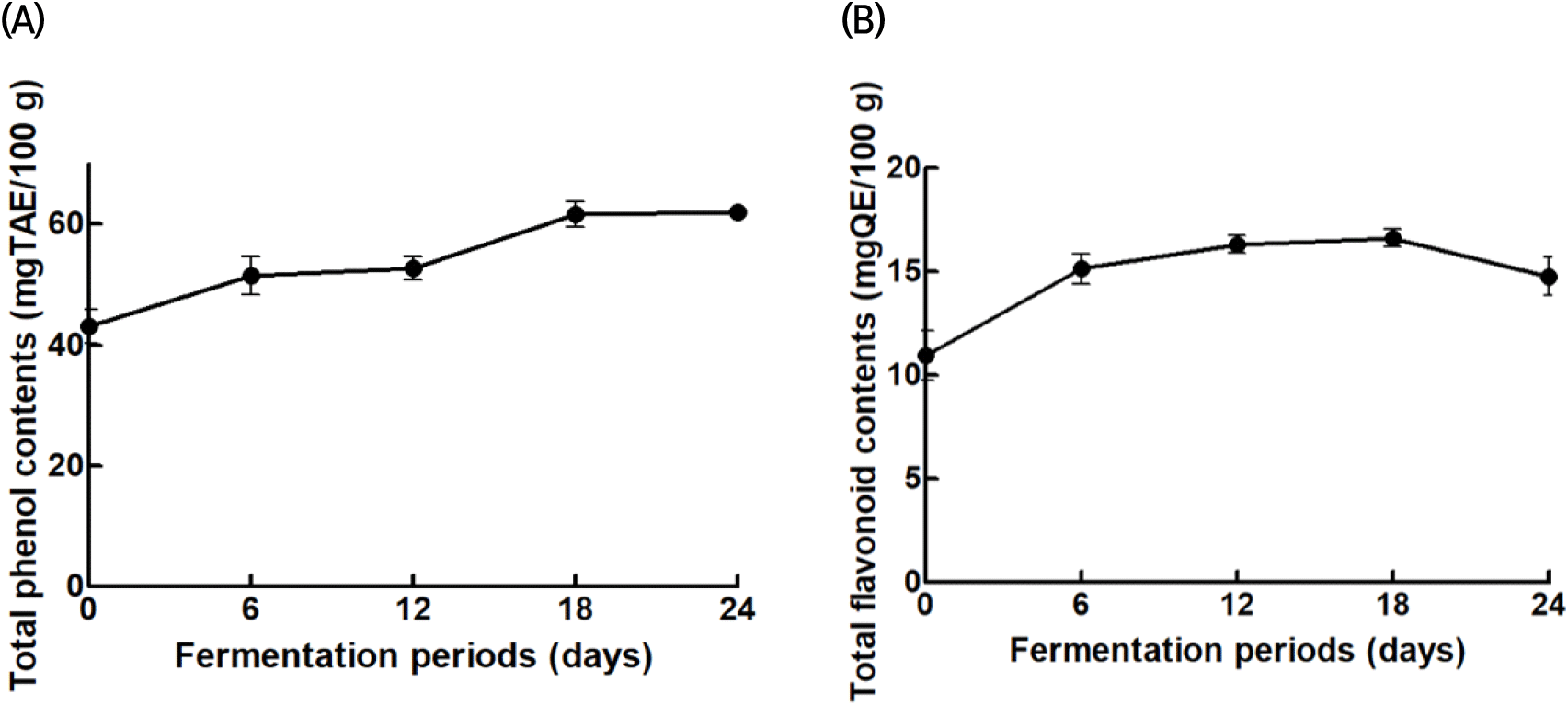
산채류를 활용한 복합발효물의 DPPH radical 소거능 및 ABTS radical 소거능 결과는 Fig. 4와 같다. 발효 초기 DPPH 및 ABTS는 각각 33.80%, 31.27%로 확인되었고 발효기간이 길어짐에 따라 점차 증가하여 12일 차에 각각 50.50%, 53.72%로 급격히 증가하는 것을 확인하였다. 그 후 증가폭은 점차 감소하여 최종적으로 24일 차에 각각 53.82%, 53.69%로 확인되었다. Fig. 3에 나온 total phenol 및 total flavonoid 함량과 비슷한 경향을 보이는 것을 확인하였고, 이 결과는 위 phenolic acid 분석 결과와도 연관성이 있는 것을 확인하였다. 이는 앞선 연구에서 발효가 진행됨에 따라 total phenol, total flavonoid 함량, 그리고 phenolic acid 화합물 함량이 항산화활성과 밀접한 연관이 있고, 발효가 진행되면 점차 증가하다가 발효기간이 길어지면 오히려 감소한다는 결과와 유사한 것을 확인하였다(Jo, 2020; Kim, 2021).
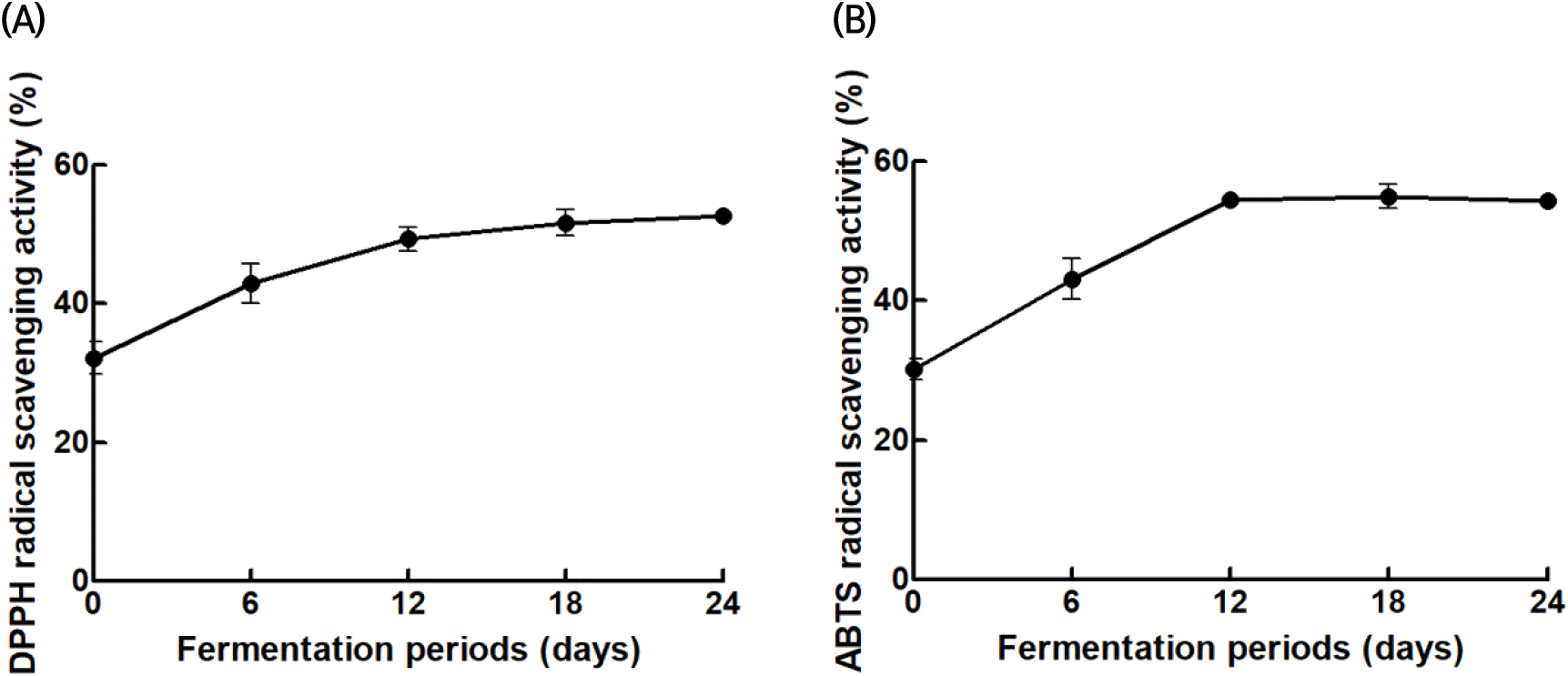
산채류를 활용한 복합발효물의 NO 생성 억제능의 결과는 Fig. 5와 같다. 복합발효물의 NO 생성 억제를 확인하기 위해 6일 차별 시료를 각 10배, 5배 희석하였다. 모든 시료 처리군에서 10배보다 5배 희석하였을 때 NO 생성 억제능이 뛰어난 것을 확인할 수 있었고, 5배 희석한 시료의 결과에서 LPS 처리군 대비 0일 차 44.9±0.5%, 6일 차 11.5±0.4%, 12일 차 10.6± 0.5%, 18일 차 13.0±2.0%, 24일 차 12.3±0.5%의 NO가 생성됨을 확인하였다. 0일 차 시료는 55.1%의 NO 생성 억제능을 보였으며, 12-24일 차 시료에서는 85% 이상의 NO 생성 억제능을 보였다. 위 결과를 토대로 발효기간이 길어짐에 따라 NO 생성 억제능이 0-6일 차 사이에 급격히 증가하였고, 그 후 비슷한 수준을 유지하는 것을 확인하였다.
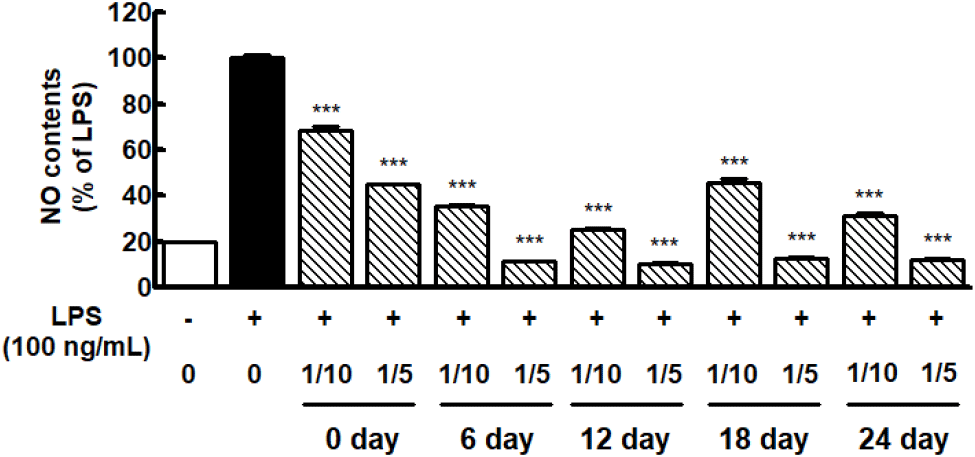
안정화된 RAW 264.7 세포에 LPS 처리 시 증가하는 iNOS, COX-2, TNF-α의 단백질 발현 양상을 western blot을 통해 분석하였다(Fig. 6). 복합발효물 처리에 따른 iNOS, COX-2, TNF-α 단백질발현양상을 분석한 결과 LPS 처리한 대조군에 비해 복합발효물 6일 차 이상부터 발효일이 길어질수록 단백질 발현을 억제하는 것을 확인하였다. 이러한 결과는 복합발효물은 iNOS, COX-2, TNF-α의 단백질발현을 억제함으로써 염증 반응을 억제하는 효과를 나타낸다는 것을 시사한다. 앞선 연구에서 꾸지뽕을 유산균을 활용하여 발효하였을 때, NO 생성 억제능과 항염증 효과가 증가한다는 것에 대한 보고가 있었고(Youn, 2022), 더덕 및 도라지에도 그 자체로도 NO 생성 억제능과 항염증 효능이 있지만, 발효를 통하면 더욱 증진된다는 보고가 있었다(Lee, 2023; Nam, 2015).
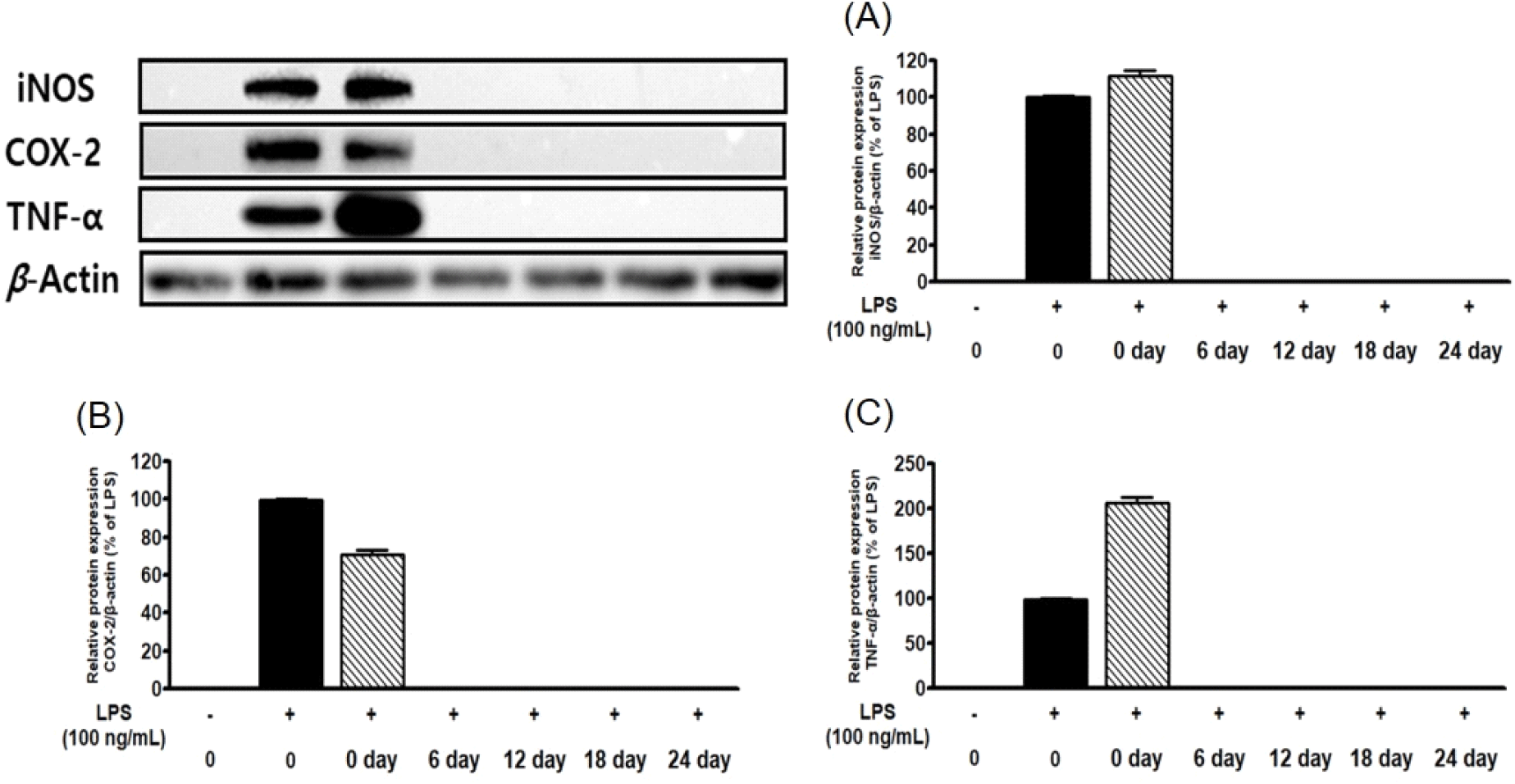
4. 요약
저이용 임산자원으로 보고된 꾸지뽕 및 돌배를 이용하여 koji, yeast, LAB을 통한 단일 및 복합 발효를 진행하였고, 복합발효를 이용하는 것이 생리활성물질 전환이 뛰어나다는 것을 확인하였다. 이에 폐 및 기관지에 효능이 있다고 밝혀진 더덕 및 도라지와 혼합하여 국균 및 유용미생물을 활용한 복합발효물의 기간별 분석을 진행하였다. pH와 총산도는 발효초기부터 24일 차까지 큰 변화는 보이지 않았고, 반면 °Brix와 고형분함량은 6일 차에 급격히 감소하는 경향을 확인하였다. Phenolic compound를 분석한 결과로 chlorogenic acid, 4-hydroxybenzoic acid, vanillic acid, caffeic acid는 발효초기(각 5.43±0.16 μg/mL, 12.30±0.17 μg/mL, 6.79±0.19 μg/mL, 28.14±0.87 μg/mL)부터 18일 차까지(각 29.81±0.30 μg/mL, 34.22±0.13 μg/mL, 28.86±0.50 μg/mL, 45.65±0.26 μg/mL) 꾸준히 증가하는 반면, ferulic acid, taxifolin, cinnamic acid, quercetin은 12일 차까지 증가하다가(각 23.22±0.67 μg/mL, 11.55±0.26 μg/mL, 0.84±0.01 μg/mL, 1.63±0.02 μg/mL) 18일이 지나면서 오히려 감소하는 경향을 보였다(각 17.74±0.19 μg/mL, 6.80±0.09 μg/mL, 0.72±0.01 μg/mL, 1.81±0.02 μg/mL). Total phenol, total flavonoid 함량 및 항산화활성(DPPH, ABTS)은 발효 초기부터 18일 차까지 꾸준히 증가하다가 24일부터는 비슷한 수준으로 유지되거나 오히려 감소하는 경향을 보였다. 이는 항산화활성이 높은 성분인 chlorogenic acid, 4-hydroxybenzoic acid, vanillic acid 및 caffeic acid의 함량 변화와 비슷한 경향으로 phenolic compound에 의하는 것으로 판단된다. 또한, NO 생성 억제능을 확인한 결과, 발효초기보다 6일 차 때 NO의 생성이 급격히 억제되는 것을 확인하였고(55.1% to 87.7%), 그 후에는 비슷한 수준을 유지하는 것을 확인하였다. 항염증 관련 단백질 발현 양상 실험에서도 역시 6일 차 이후로 iNOS, COX-2, TNF-α를 억제하는 것을 확인하였다. 따라서 본 연구결과, 꾸지뽕, 돌배, 더덕 및 도라지를 혼합하여 유용미생물(koji, yeast, LAB)을 이용해 복합발효를 했을 시, 12-18일 사이에 항산화 및 항염증 효능이 가장 높은 것을 확인하였다. 이를 통해서 저이용 임산자원의 식품소재로서의 활용 가능성을 확인하였다.
